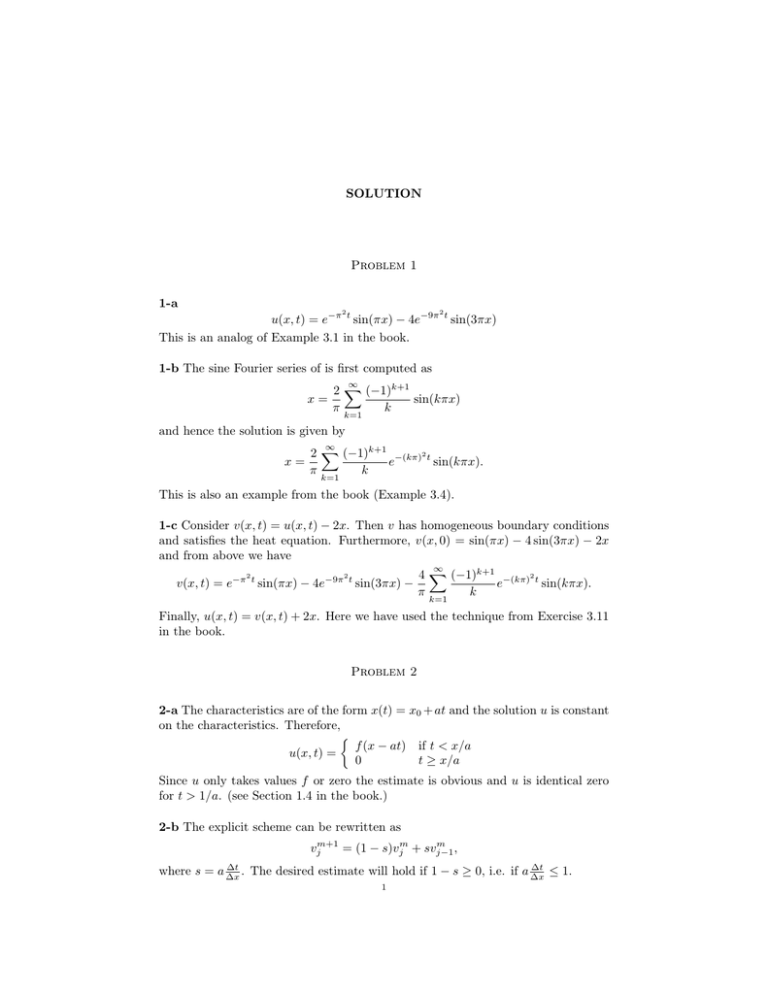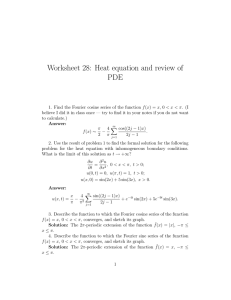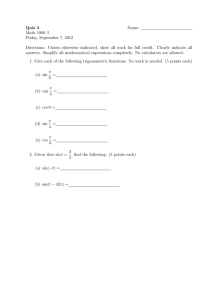SOLUTION Problem 1 1-a u(x, t) = e
advertisement

SOLUTION Problem 1 1-a 2 2 u(x, t) = e−π t sin(πx) − 4e−9π t sin(3πx) This is an analog of Example 3.1 in the book. 1-b The sine Fourier series of is first computed as ∞ 2 X (−1)k+1 x= sin(kπx) π k k=1 and hence the solution is given by ∞ 2 X (−1)k+1 −(kπ)2 t x= e sin(kπx). π k k=1 This is also an example from the book (Example 3.4). 1-c Consider v(x, t) = u(x, t) − 2x. Then v has homogeneous boundary conditions and satisfies the heat equation. Furthermore, v(x, 0) = sin(πx) − 4 sin(3πx) − 2x and from above we have ∞ 4 X (−1)k+1 −(kπ)2 t −π 2 t −9π 2 t e sin(kπx). v(x, t) = e sin(πx) − 4e sin(3πx) − π k k=1 Finally, u(x, t) = v(x, t) + 2x. Here we have used the technique from Exercise 3.11 in the book. Problem 2 2-a The characteristics are of the form x(t) = x0 + at and the solution u is constant on the characteristics. Therefore, f (x − at) if t < x/a u(x, t) = 0 t ≥ x/a Since u only takes values f or zero the estimate is obvious and u is identical zero for t > 1/a. (see Section 1.4 in the book.) 2-b The explicit scheme can be rewritten as m vjm+1 = (1 − s)vjm + svj−1 , ∆t ∆t where s = a ∆x . The desired estimate will hold if 1 − s ≥ 0, i.e. if a ∆x ≤ 1. 1 2 SOLUTION 2-c The implicit scheme can be rewritten as m+1 vjm+1 = (1 + s)−1 vjm + s(1 + s)−1 vj−1 Since the coefficients (1 + s)−1 and s(1 + s)−1 are always positive, and sum up to one the estimate follows by induction with respect to m and j. If we compute vjm+1 in the order v1m+1 , v2m+1 , vnm+1 there is no need to solve a linear system. Problem 3 3-a The identity follows by multiplying the differential equation by u and integration by parts. If f = 0 then this identity implies that u = 0, so we have uniqueness. 3-b Constants satisfies the boundary value problem with f = 0 so we do not have uniqueness. Furthermore, if u is a solution then Z 1 Z 1 f (x) dx = − uxx (x) dx = 0 0 0 by the boundary condition. 3-c Assume f = 0 and a = 0. Then we will have Z 1 Z 1 Z 1 2 (ux (x, t)) dx + λ u(x) dx = (ux (x, t))2 dx = 0, 0 0 0 so u is a constant, and it has integral equal to zero. So u = 0, and then λ = 0 by (12). 3-d It follows from 3-b above that Z λ= 1 f (x) dx = c0 /2. 0 Furthermore, by writing u as a Fourier cosine series on the form ∞ b0 X + bk cos(kπx) u(x) = 2 k=1 we have that Z b0 = 2 1 u(x) dx = 2a. 0 Finally, by inserting the expansion of u and f into the equation (12) we obtain bk = ck /(kπ)2 . So the solution is ∞ X ck u(x) = a + cos(kπx), and λ = c0 /2. (kπ)2 k=1 (see Section 3.6 in the book for the cosine series.)





